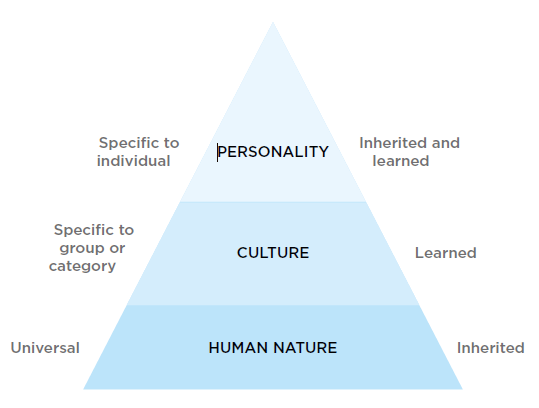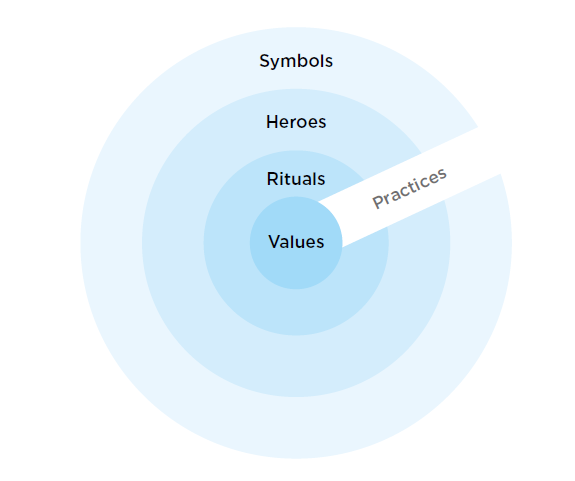The One Culture Shift That Drives Growth in Technological Disruption

Image Source: Freepik
Culture, this intangible and sometimes elusive concept, is often considered one of the most significant factors influencing organizational performance. Unlike formal strategies or operational procedures, culture is difficult to pinpoint: where does it start and where does it end? It is both impactful and challenging to define.
Geert Hofstede, a reputable Dutch social psychologist, considers culture as something that cannot be individual and must always be a collective phenomenon, as it is shared with others. He defines culture as “the collective programming of the mind which distinguishes the members of one group or category of people from others.” Culture is learned, deriving from the environment where one lives (see Figure 1).

Figure 1. Three Levels of Uniqueness in Mental Programming | Source: G. Hofstede (2010). Cultures and Organizations: Software of the Mind, third edition
Hofstede also mentions the terms used to define the way culture manifests, terms that contour cultural differences: symbols, heroes, rituals, and values (See Figure 2). Values represent the deepest manifestation of culture. From the corporate perspective, Merriam-Webster dictionary defines culture in a similar way, saying it is “the set of shared attitudes, values, goals, and practices that characterizes an institution or organization.”

Figure 2. The “Onion”: Manifestations of Culture at Different Levels of Depth | Source: G. Hofstede (2010). Cultures and Organizations: Software of the Mind, third edition
Due to technological developments and the proliferation of real-time information, businesses today can operate globally. The innovation process occurs much more quickly since access to resources is improved, producing results at a faster pace than before. To adapt swiftly and generate the desired outcomes, an organization should have the appropriate behaviors and practices in place. This all comes down to culture.
Read More >> RTO Mandates in 2025: A Culture Boost or a Backward Step?
Building an Adaptive Culture
For a global company, culture is even more important given the diverse backgrounds of employees across different locations. Therefore, investing in actions that glue them together and strengthen the culture could make the difference in creating employee engagement. An environment of collaboration with swift decision-making practices is very much needed in times of rapid technological change. This begs the question: how can this be achieved?
1. Define values that support agility and innovation. Values and behaviors create the foundation for how organizations, through people, respond to change and, hence, to technological disruptions. A culture rooted in values like adaptability, integrity, talent recognition, and collaboration ensures that innovation is pursued more rapidly, ethically, and strategically by the entire organization. Aligning innovation efforts with core behaviors—such as respect, consumer-centricity, and accountability—helps maintain trust, direction, and long-term sustainability in the context of technological disruption.
For example, Microsoft, the multinational technology company, states that its values are aligned with the company’s mission and support the culture. In the company’s own words, they say “our values align to our mission, support our culture, and serve as a declaration of how we treat each other, our customers, and our partners.” Given Microsoft’s massive global footprint, its core values of respect, integrity, and accountability reflect its commitment to nurturing an inclusive, ethical, and responsible culture where diverse perspectives are valued and individuals take ownership of their actions and outcomes.
Similarly, the PepsiCo Way is defined by a set of behaviors supporting innovation and rapid change. These include acting with integrity, taking ownership, embracing diverse perspectives, prioritizing consumers, celebrating success, and fostering efficiency, all of which contribute to making culture a competitive advantage.
PepsiCo acknowledges the role culture plays in shaping its actions. Company chairman and CEO Ramon Laguarta states, “I think we can make our culture a competitive advantage, and that’s why the PepsiCo Way is so, so important.”
2. Leaders should set the tone. Leaders should be and act as role models and promoters of the culture chosen by the organization. Nothing destroys culture more than setting rules and not abiding by them. Successful leaders should set aside time for introspection, as in the end, values and behaviors represent choices. An organization cannot leave the development of its culture to chance, as that risks its future.
3. Consider continuous improvement and adaptability as foundations. As the organization defines its set of values, behaviors, practices, and the corresponding metrics to evaluate them (for example, employee engagement surveys), it should also seek to identify and correct any misalignments. Therefore, the status of the company’s culture and its practices must be measured regularly through internal surveys, since these can strengthen, weaken, or delay it from generating the desired outcomes. And since technology advances rapidly, these realignments based on regular diagnoses should happen recurrently and swiftly as well. Implementing change and innovation following a diagnosis is more effective when done regularly rather than at infrequent intervals.
Organizations, much like living organisms, risk becoming rigid and resistant to adaptation if they do not continuously evolve. Just like human bodies, they can ossify. As trends and the speed of their arrival are challenging to predict, success should not be defined by accurately foreseeing the future, but by designing a culture that supports the continuous transformation of the business to adapt to uncertainty.
4. Promote continuous learning. A company and people who are ready to learn and adapt can manage disruptions more easily. This happens at the individual, team, and organizational levels. Reskilling and upskilling have become essential for organizations to remain competitive nowadays. Reskilling involves training employees in new skills to adapt to changing job roles, while upskilling focuses on enhancing existing capabilities to meet evolving demands. By investing in continuous learning, companies ensure that their workforce remains agile, capable, and prepared for future challenges. Organizations that prioritize continuous learning create a culture of adaptability.
5. Ensure psychological safety. Ensuring psychological safety in the workplace is crucial because it allows employees to feel safe to voice their ideas, take risks, and challenge the status quo without fear of embarrassment or reprisal. This way, creative solutions are more likely to be proposed. Organizations that ensure psychologically safe environments encourage open dialogue, which is key to continuous innovation. By creating an environment where employees feel valued and empowered to think outside the box, companies can drive breakthrough innovations and stay competitive in a rapidly and constantly changing environment.
6. Design swift decision-making processes. Implementing agile processes and decentralizing teams can hasten adaptation. On the other hand, delays in decision-making can result in missed opportunities or ineffective responses. Companies that foster a culture that values adaptability and calculated risk-taking, establish clear decision-making frameworks, empower employees at all levels to take initiative, and leverage real-time data and technology for informed choices are able to embrace change with less resistance.
Read More >> Magnifying Microcultures: When Employees Follow Peers, Not Companies
Looking to the Future
Ultimately, technological change is inevitable. However, its impact depends on how the organization responds. When change is embedded in an organization’s culture, resilience becomes a part of it, too, as employees are more likely to be flexible and adaptable, developing a mindset of continuous evolution.
**********
Editor’s Note: This article was originally published in Performance Magazine Issue No. 32, 2025 – Employee Performance Edition.
